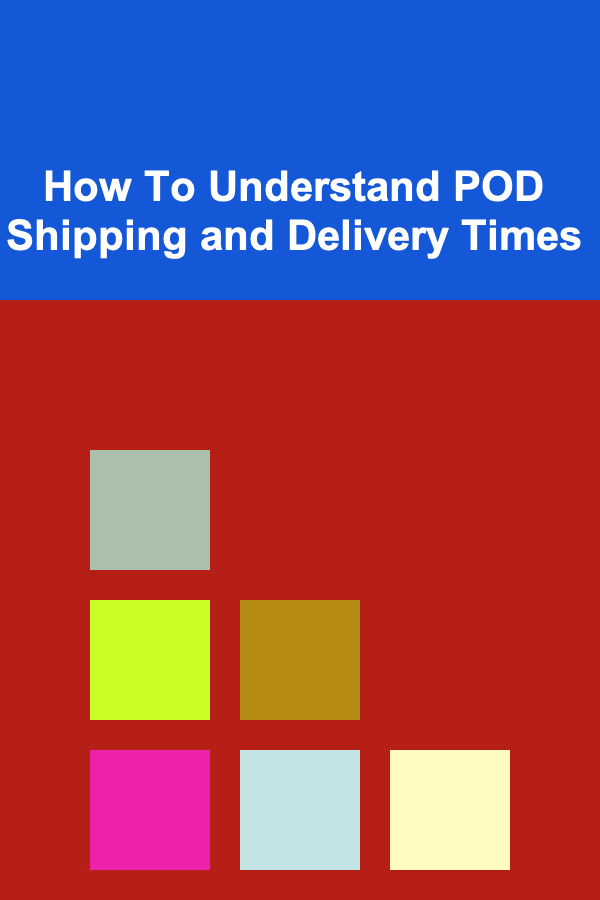
How To Understand POD Shipping and Delivery Times
ebook include PDF & Audio bundle (Micro Guide)
$12.99$6.99
Limited Time Offer! Order within the next:

Print on Demand (POD) shipping is a concept that has become increasingly popular due to the rise of e-commerce and the demand for personalized products. Whether you're a seller or a buyer, understanding the nuances of POD shipping and delivery times is crucial for ensuring customer satisfaction and managing business expectations effectively. This comprehensive article will dive deep into the world of POD shipping and delivery times, explaining how the process works, what factors influence delivery times, and how to navigate these challenges.
What is POD Shipping?
Print on Demand (POD) is a fulfillment model that allows sellers to design products (such as t-shirts, mugs, posters, and other custom goods) and have them printed and shipped only when an order is placed. This business model eliminates the need for inventory storage and minimizes upfront costs. Sellers collaborate with POD providers who handle the production, packing, and shipping of products directly to customers.
The POD Process
- Customer Places an Order: The POD process begins when a customer places an order on the seller's online store, selecting a product that has a custom design.
- Order Sent to POD Provider: Once an order is confirmed, the details are sent to the POD provider, who then prepares to print the design on the chosen product.
- Printing and Fulfillment: The POD provider prints the design on the product, packages it, and prepares it for shipment.
- Shipping: After the product is printed and packed, it is shipped directly to the customer's address.
Unlike traditional retail, POD allows businesses to operate without holding stock or dealing with warehousing, reducing financial risk for the seller. However, this process comes with its own set of challenges, particularly regarding shipping and delivery times.
Key Factors That Affect POD Shipping Times
When dealing with POD shipping, delivery times can vary greatly depending on several factors. Sellers and buyers need to understand these factors to set realistic expectations and minimize frustration.
1. Production Time
The time it takes to print and prepare a product is one of the most important factors in determining shipping times. While the printing process itself is usually fast, it may take anywhere from 1 to 5 business days depending on the complexity of the design, the type of product, and the POD provider's workload.
For example, printing a simple design on a t-shirt might take less time than printing intricate artwork on a canvas or a custom-printed book. Additionally, if a POD provider is experiencing a surge in orders (e.g., during peak shopping seasons like holidays), production times can be delayed.
2. Shipping Carrier and Method
Once the product has been printed, it needs to be shipped to the customer. The shipping carrier selected by the POD provider plays a significant role in delivery times. Common carriers include USPS (United States Postal Service), FedEx, UPS, and DHL. Each carrier has its own shipping options, including:
- Standard Shipping: This is usually the most economical option, but it may take longer to arrive, especially for international shipments.
- Expedited Shipping: This service guarantees faster delivery but at a higher cost.
- Express Shipping: For urgent deliveries, express shipping options are available, often providing next-day or two-day delivery.
3. Shipping Destination
The delivery address also plays a critical role in determining the overall shipping time. Domestic shipments typically arrive faster than international shipments, especially if they are shipped across long distances or from one continent to another. International shipments are subject to additional customs processing, which can delay delivery.
Shipping to rural areas may also take longer than delivery to urban centers, as less frequent delivery routes can extend transit times.
4. Order Volume and Peak Seasons
During periods of high demand, such as holidays, special promotions, or sales events like Black Friday, POD providers and shipping carriers experience higher order volumes. This can result in longer production and shipping times. Sellers should plan for potential delays during these peak periods and communicate this to customers beforehand.
5. Customs and Import Regulations (For International Shipments)
For international orders, customs and import regulations can cause significant delays. When a POD product is shipped across borders, it must pass through customs, which can take anywhere from a few days to several weeks. The complexity of the customs process and the regulations of the destination country can affect delivery times.
Some countries may require additional paperwork, such as proof of origin, invoices, or other forms. Delays in processing these documents can lead to longer delivery times, which can be frustrating for both the seller and the customer.
6. Weather and Unforeseen Events
Sometimes, external factors like extreme weather, natural disasters, or other unforeseen events can cause delays in shipping. For example, hurricanes, snowstorms, or even labor strikes can disrupt the normal flow of goods through transportation networks, leading to delays.
While these situations are beyond the control of both POD providers and sellers, it's important to keep customers informed about potential delays. Transparent communication helps to maintain customer satisfaction, even during unforeseen circumstances.
How to Manage Delivery Times Effectively
For both sellers and buyers, managing delivery times effectively is key to ensuring satisfaction and minimizing issues.
For Sellers:
- Set Clear Expectations
From the beginning, sellers should set clear expectations regarding production and delivery times. This includes specifying average production times, expected shipping durations, and possible delays during peak seasons. Having this information readily available on the product page and in the checkout process helps customers understand what to expect.
- Communicate with Customers
Proactive communication is crucial when it comes to shipping delays. If a product is delayed during production or shipping, notify the customer as soon as possible and provide an updated delivery date. Offering tracking information once the product ships can also help customers monitor their order's progress and reduce anxiety.
- Choose Reliable POD Providers and Carriers
It's important for sellers to partner with reliable POD providers who have a track record of delivering products on time. Similarly, selecting a reputable shipping carrier ensures that products arrive promptly. Researching the shipping policies of different providers and carriers can help sellers make informed decisions.
- Offer Multiple Shipping Options
To give customers flexibility, sellers can offer multiple shipping options (e.g., standard, expedited, express). This allows buyers to select the option that best meets their needs and timeline.
- Optimize Inventory and Production Systems
For sellers who work with multiple POD providers or offer a wide range of products, streamlining production processes can help reduce delays. Maintaining a good relationship with POD partners and ensuring that inventory systems are efficient and well-organized can significantly improve delivery times.
- Consider Using a Fulfillment Service
Some POD providers offer fulfillment services, meaning they handle all aspects of production, packaging, and shipping. These services can help streamline the entire process and ensure faster delivery times, especially when dealing with large volumes of orders.
For Buyers:
- Check Estimated Delivery Times
Before placing an order, buyers should check the estimated delivery times provided by the seller. This will give them an idea of how long it will take to receive their product. Keep in mind that some delays are inevitable, especially during peak seasons.
- Track Your Order
Once the order has shipped, most POD providers will offer a tracking number. Use this tracking information to monitor the progress of your shipment. If there are any delays or issues with delivery, tracking allows you to stay informed.
- Consider the Shipping Method
If you need a product by a specific date, consider selecting an expedited or express shipping option. While this will cost more, it ensures that the product will arrive on time.
- Prepare for Possible Delays
While delays are not always avoidable, being flexible and patient can help buyers manage expectations. Factors such as customs delays, weather, or unexpected production issues can impact delivery times. Understanding these factors will help buyers remain patient if their order is delayed.
Conclusion
Understanding POD shipping and delivery times is essential for both sellers and buyers to ensure smooth transactions. The production time, shipping carrier, destination, and order volume all affect the speed of delivery. For sellers, setting clear expectations, choosing reliable providers, and offering multiple shipping options are key strategies to ensure timely delivery. Buyers, on the other hand, should check estimated delivery times, track their orders, and be prepared for possible delays, particularly during busy seasons or international shipping.
By navigating the complexities of POD shipping with awareness and planning, sellers can improve their operations, and buyers can enhance their shopping experience, ensuring that everyone involved has a positive outcome.

How to Create a Checklist for Managing Shipping Documentation
Read More
How to Market Your Rental Property on Social Media
Read More
How to Plan a Cozy Movie Night Party for Friends
Read More
Turning Your Deep Learning Knowledge into a Profitable Venture
Read More
How To Overcome Procrastination (Psychological Hacks)
Read More
10 Tips for Creating an Engaging Conference App
Read MoreOther Products

How to Create a Checklist for Managing Shipping Documentation
Read More
How to Market Your Rental Property on Social Media
Read More
How to Plan a Cozy Movie Night Party for Friends
Read More
Turning Your Deep Learning Knowledge into a Profitable Venture
Read More
How To Overcome Procrastination (Psychological Hacks)
Read More